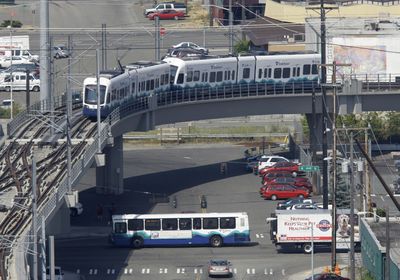Seattle light rail on track to open
Link system took decades to finish

SEATTLE – More than four decades after political wrangling and recession ran a mass transit rail plan for Seattle off the tracks, trains are finally running.
Service on the new Link system will begin Saturday with live music, free rides and shuttle service to some stations, ending the city’s status as one of the nation’s largest without a dedicated rail transit system.
“I’m very excited about it,” said Nicole Von Suhr, 43, an emergency room physician who lives a few blocks from a new light rail station in south Seattle’s Columbia City neighborhood. She said she looks forward to taking it to the airport and downtown.
Officials are planning for 40,000 to 50,000 riders on opening day, when the Seattle Sounders will be playing a soccer exhibition game with Chelsea of the English Premier League before some 60,000 fans and thousands will be heading out to the daylong Bite of Seattle restaurant festival at the Seattle Center.
After that, average daily ridership is projected at 26,000 riders, based on figures from the startup of a system in Phoenix in December, said Joni Earl, chief executive of Sound Transit, the three-county agency that is building and operating the system.
Sixty days of test runs began in May over the 13.9-mile light-rail line between the downtown area and a station north of Seattle-Tacoma International Airport. The remaining 1.7-mile section of track to the airport is set to open in December.
The line is probably the most complicated system in the country, as it runs through tunnels beneath downtown and Beacon Hill, at street grade in the city’s south end and on elevated tracks to the airport, Earl said.
Work has started on a line running northeast from downtown to the University of Washington. Last year, voters approved extensions to the north, south and east that will boost the network to 55 miles by 2023. Longer-term plans call for trains to run south to Tacoma, north to Everett and east to Redmond.
To see the trains finally rolling is a joy for Jim Ellis, 87, a retired municipal bond lawyer who has been advocating rail transit in Seattle for more than 40 years.
“It really feels good. It’s been a long time coming,” said Ellis. “I was fearing that it might not happen.”
In 1968 Ellis was the moving force behind a heavy rail transit plan that failed at the polls when suburban opposition swamped support in the city. Voters again rejected rail transit in 1970 as a Boeing Co. tailspin plunged the area into recession.
“Nobody was willing to vote for anything that cost money,” Ellis recalled.
With the second defeat, $765 million in federal matching money – more than $4.7 billion in today’s dollars – went instead to build trains in Atlanta.
Debate over what to do next raged for decades as Seattle became one of the worst cities in the country for traffic congestion.
Sound Transit, formed by a public vote in King, Pierce and Snohomish counties in 1996, began with long-range commuter buses and Sounder commuter trains that run a few times a day on regular railroad tracks to suburbs north and south of Seattle.
Meanwhile, Seattle voters unhappy with the regional agency’s limited plans for service in the city itself approved a separate monorail system, only to kill it in 2005 in the face of looming budget shortfalls.
At Sound Transit, repeated cost overruns and management problems culminated in a highly critical federal audit shortly before Earl took over in 2001. The agency got a clean bill of health two years later and has largely kept within its budgets and timelines since then.
Construction of the line has helped transform some of Seattle’s grittiest neighborhoods. Artworks costing nearly $5.6 million have been installed along a route once pockmarked with used car lots, dingy motels and partly vacant strip malls.
Test trains have been running for weeks, with no major accidents or injuries to motorists or pedestrians. Neighbors in Tukwila have complained about screeching from train wheels, so sound barriers will likely be added or nearby homes will be provided with soundproofing, agency officials said.
Sound Transit critics remain dubious. Real estate developer Kemper Freeman Jr. has been fighting rail-based mass transit as long as Ellis has been pushing for it. Freeman contends expanding bus service would have been cheaper and more effective because the region isn’t densely populated enough to completely embrace rail transit.
“We’re choosing the most expensive, least effective type of transit,” Freeman said. “It literally takes the density of a Manhattan to make these things work, and this is just not Manhattan.”